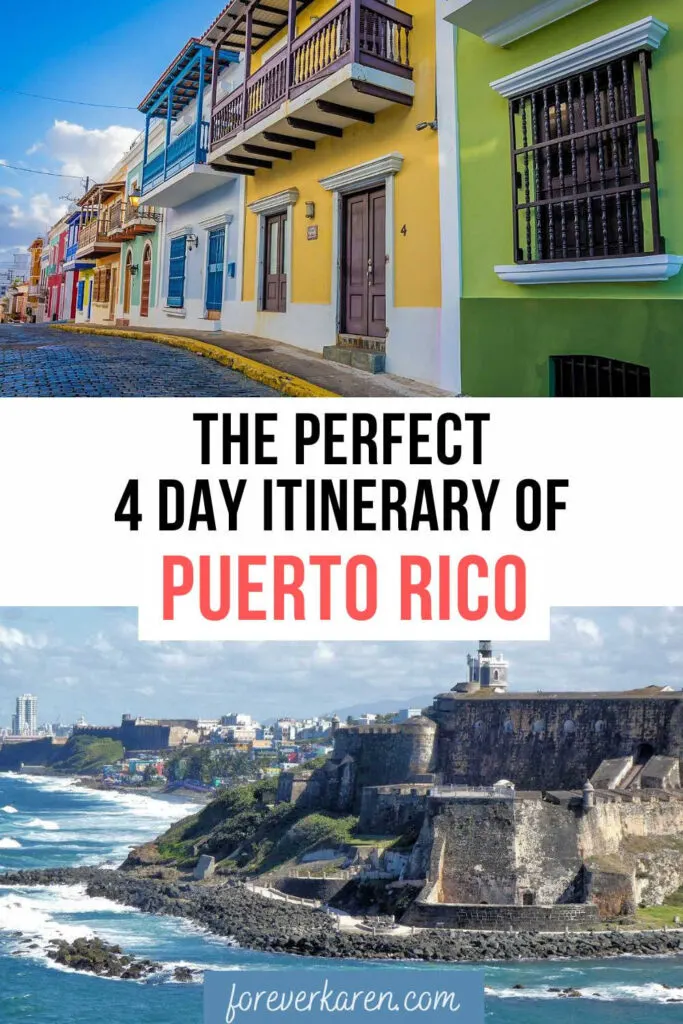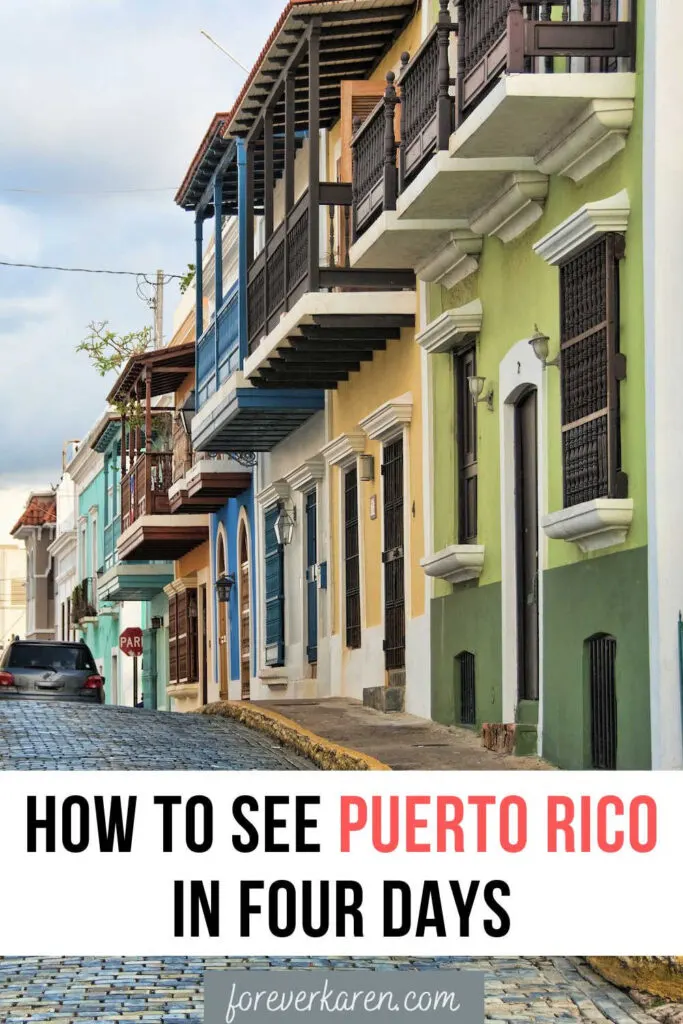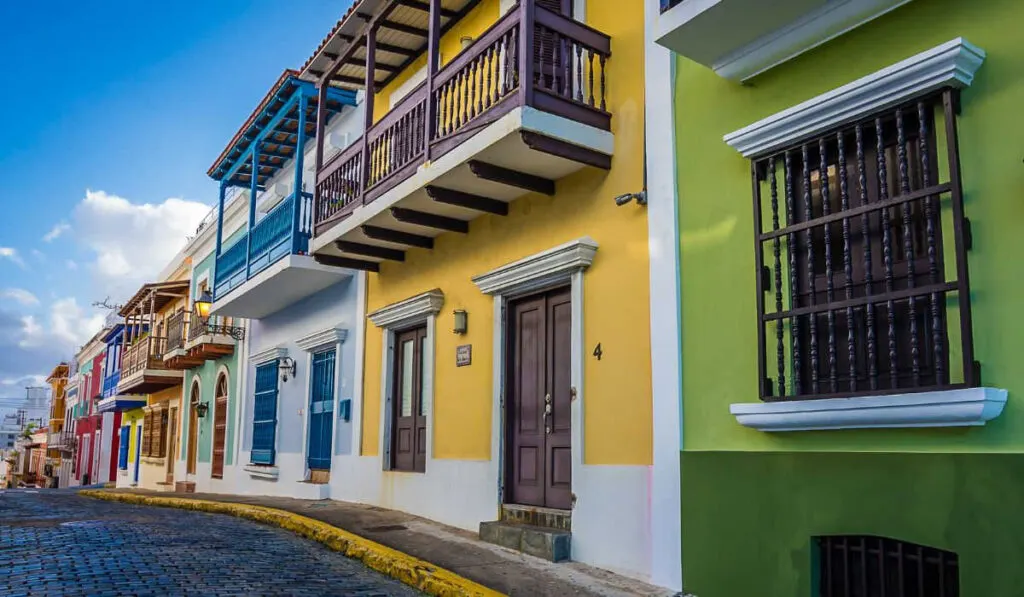
Are you wondering how to spend 4 days in Puerto Rico without missing the best of it? Well, you’re in luck! In this article, you’ll find the most epic ways to spend your time in Puerto Rico, along with everything you need to know before planning your trip.
Puerto Rico, often referred to as the “Island of Enchantment,” has been winning the hearts of tourists from around the globe. Its pristine beaches, colonial architecture, diversified landscapes, and tropical climate make it an ideal destination.
While some come from the coldest climates further north, others stay before or after a Caribbean cruise. It’s a favorite cruise port in the Eastern Caribbean. With its cruise port in Old San Juan, you’ll have access to the historical parts of the city.
If you know where to go, you can immerse yourself in many one-of-a-kind experiences and enjoy authentic Puerto Rico food.
This 4-day Puerto Rico itinerary is all you need to plan a fantastic getaway to this sun-kissed Caribbean paradise.
While four days isn’t much time, this guide will give you a snippet of what Puerto Rico offers. Plus, it’s a great introduction, mainly for first-time travelers.
Planning A Trip To Puerto Rico
Puerto Rico is a beautiful Caribbean Island brimming with history, culture, and natural beauty. Being a territory of the United States, it’s easily accessible by Americans, who won’t need to exchange currency.

Being in the Caribbean, it doesn’t experience seasons. Expect temperatures from the 70s to mid-80s, although it may feel hot with the added humidity.
January offers the coolest temperatures. April to November is the rainy season. It’s also important to note that October to November is hurricane season.
To deal with the humidity, pack as you would for a Caribbean cruise with lightweight clothing made of natural fibers and fast-drying items. Bring plenty of sunscreen, sunglasses, and mosquito repellent.
Mosquitoes are rampant in Puerto Rico, especially in the jungle area. Before you go, it’s essential to know they can carry dengue fever and the Zika virus.
This itinerary includes road trips outside the downtown core. While you can take a bus tour, it’s best to rent a car. Car rentals are readily available at Luis Muñoz Marín International Airport, also known as San Juan Airport (SJU).
Where To Stay In Puerto Rico
Accommodations are much more affordable than in hotspots like Miami and Hawaii. Plus, with all its history, you can choose a hotel with character and charm. Most travelers stay in Old San Juan. However, if you had a longer stay, you could divide your vacation into different areas.
El Colonial offers premium accommodation in the heart of downtown for an adult-only stay. The rooms are modern, and some come with iron-railing balconies that overlook the cobblestone streets.
CasaBlanca Hotel provides the ideal location in Old San Juan. The hotel features a rooftop deck with stone bathtubs. Rooms are reasonably priced, and guests can easily access many restaurants and attractions nearby.
Guests staying at Hotel El Convento get beach privileges at Isla Verde Beach’s El Convento Beach Club. It provides an ideal location within a few minutes of the cruise dock for cruise passengers.
The Sheraton Old San Juan Hotel provides the most accessible access to the cruise port across the street. It offers lovely views of San Juan Bay and has a fantastic rooftop pool.
Now that you have accommodation, here are four days’ worth of activities.
Day 1 – Explore Old San Juan
Start the first day of your Puerto Rico trip in Old San Juan, the oldest settlement on the island. The area oozes romance with its historic culture and colonial architecture.
There is much to love about Old San Juan, but let’s start with its forts.
Tour Castillo San Felipe del Morro
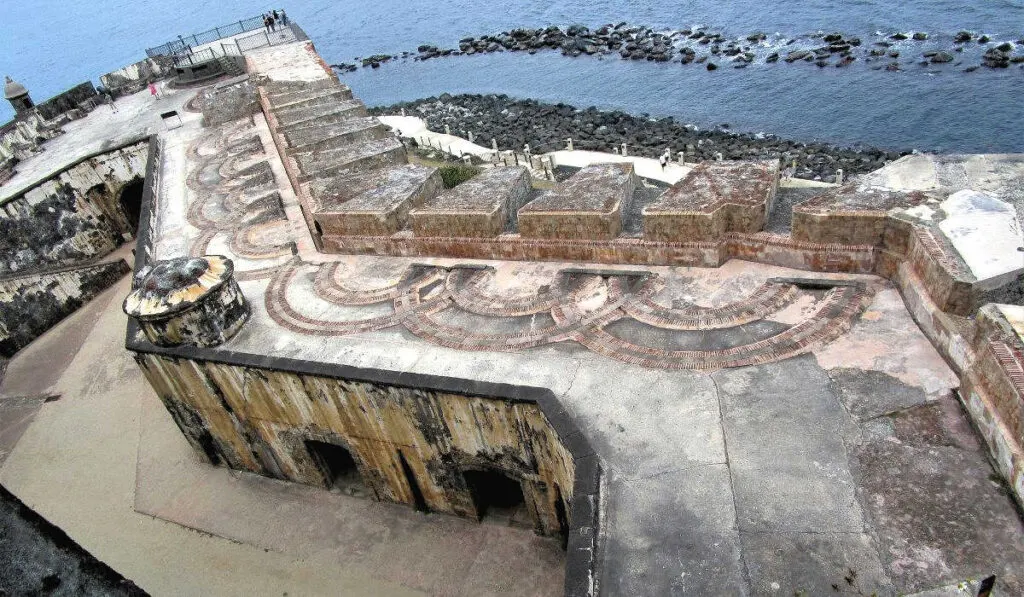
The Castillo San Felipe del Morro, often known as El Morro, was the second fort erected on the islet of Old San Juan. It sits on San Juan Bay, offering spectacular views out to the ocean. Due to its rich history, it became a UNESCO World Heritage Site in 1983.
On tour, you’ll learn its historical significance as a center for defense and trade with Spain during colonial times. You can view authentic artifacts, weapons, and uniforms by exploring the barracks, kitchens, and primitive sleeping quarters.
El Morro is the smaller of the two forts. It has six levels to explore, using tunnels, stairs, and ramps. Make sure to visit the cannon batteries, lighthouse, and garitas (sentry boxes) on the outer walls.

Walking on the lower pathways (outside the fort) next to the ocean, you can admire the towering walls, which are up to 40 feet thick in some areas. Then you’ll understand why it took 250 years to complete the impressive fortification.
Visit La Fortaleza
Located near El Morro, La Fortaleza is one of the most historic structures in Puerto Rico. While it has served as a prison, armory, and fortress, it’s currently the governor of Puerto Rico’s official residence. Walking from El Morro, you pass another historic structure, San Juan Gate.
By visiting, you’ll witness firsthand how this landmark was built over time (it dates back to 1540). Inside, you can learn about its history and tour some rooms that haven’t been modified since they were first built centuries ago.
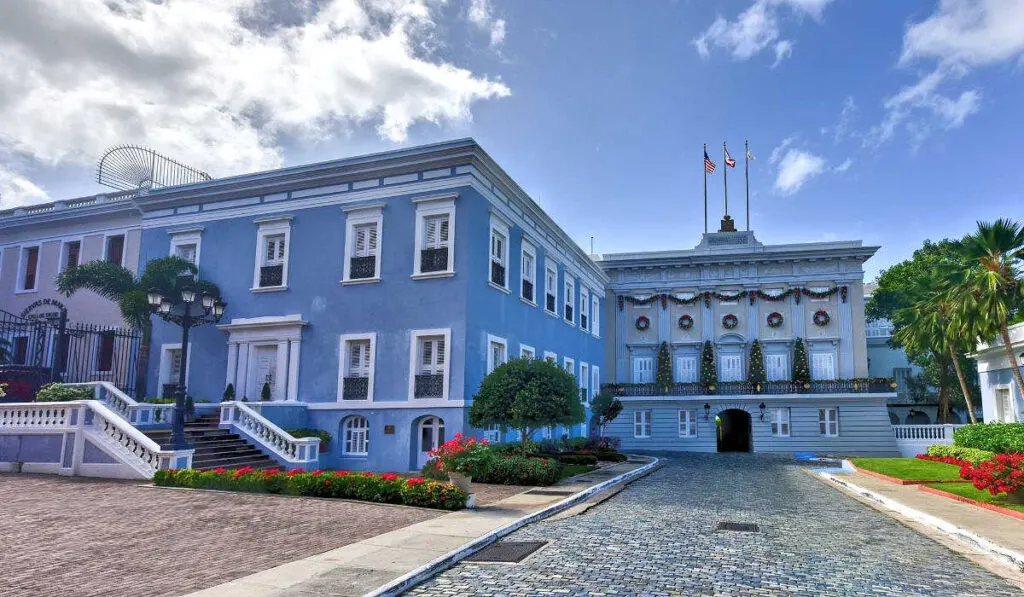
It is worth visiting not only because it has beautiful architecture and views but because it became a UNESCO world heritage site in 1983. After your visit, walk along Fortaleza Street to the second fort.
See Castillo San Cristobal
While El Morro was constructed to defend the harbor, Castillo San Cristobal provided defense for the city. Unlike El Morro, which took a staggering 250 to build, it took a mere 20 years to complete Castillo San Cristobal.
Providing you start early in the day, you can visit both forts in a day. Towering 150 feet above the ocean, the fort was named after the patron saint of travelers. Although it doesn’t appear large from the outside, the structure covers 27 acres.
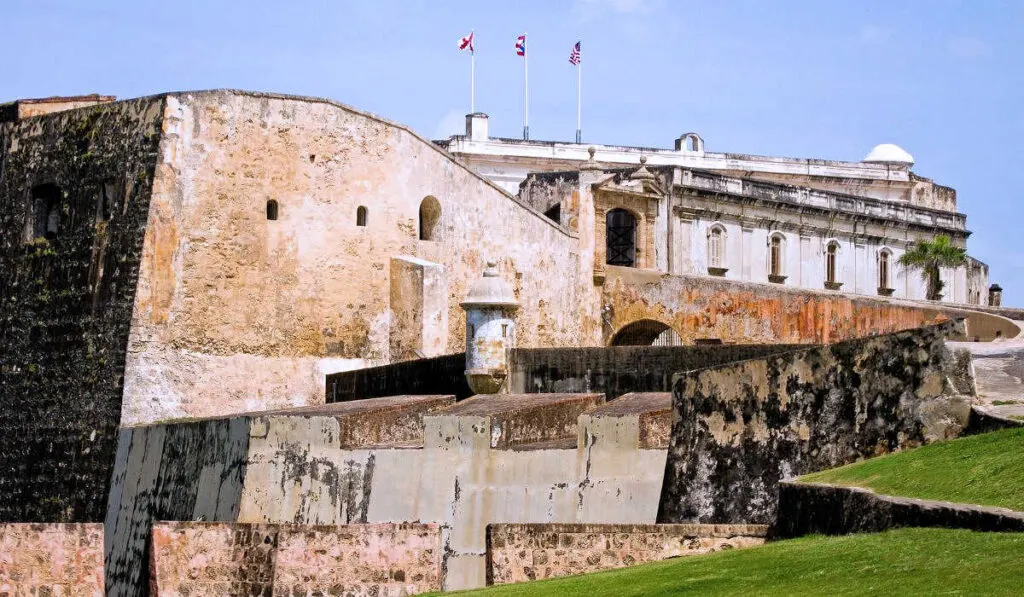
With thick walls and three levels to its fortification, it served well as a military base during World War II. It was later turned over to the US park service to preserve its cultural heritage. Today, El Morro and Castillo San Cristobal are part of San Juan’s National Historic Site.
El Escambrón Beach Time
Since both forts close early in the day, you have time for relaxation at the beach, before or after dinner. El Escambron Beach is a great place to snorkel, sunbathe, and swim.
This beautiful beach is nestled on the northwest side of Old San Juan and is one of the most beautiful beaches in the world. It’s also an ideal spot for getting your toes wet when you want to cool down after a long day.
You’ll see different wildlife like pelicans, stingrays, and even turtles swimming around in the water or resting on shoreline rocks during the afternoon hours. You might also see some dolphins frolicking in the waves if you’re lucky.
Savor Classic Pina Colada
End your first day with a classic Puerto Rico drink as you watch the sunset. A Pina Colada is a flavorful, classic tropical cocktail that is made with rum, pineapple juice, and coconut cream. The drink was invented in Puerto Rico by Don Pedro A. Ruiz.
Nowadays, you can find variations of this classic drink all over Puerto Rico. Some use ice cubes instead of crushed ice (which makes them more refreshing), and others use light rum instead of dark (and vice versa).
There’s even one made with coconut milk and without rum. It’s the perfect virgin drink if you’re not into alcohol yet want something delicious.
You can’t go wrong with La Verguenza’s rooftop restaurant for dinner. Overlooking the Atlantic Ocean, it offers Caribbean and Puerto Rican food in a low-key setting.
Day 2 – El Yunque Rainforest
El Yunque Rainforest is a popular national park in Puerto Rico and is a great place to spend your second day.
Without a tour, you’ll need a reservation, as the park limits the number of private vehicles per day. Make sure to book before arriving in Puerto Rico, as tickets sell out fast.
Located on the Sierra de Luquillo Mountain slopes, the lush rainforest covers more than 28,000 acres. It’s an area prolific with ponds, streams, and beautiful waterfalls.
See La Coca Falls
La Coca Falls is a natural wonder in El Yunque. Its water drops 85 feet down a rock wall. While the water looks refreshing, you aren’t allowed to swim there.

You’ll have access to both sides of this lovely waterfall and its surrounding area. You may choose to go hiking on trails that offer views out onto mountains covered in tropical forest vegetation. Since you’re in a tropical jungle, remember to use mosquito repellent.
Wade At Juan Diego Falls
Juan Diego Falls is a tourist favorite in the El Yunque rainforest. There are two waterfalls, with the lower one more accessible than the higher one.
A natural pool provides a cold but refreshing dip at the base of the lower falls. Accessing the higher falls (which are more spectacular) takes a strenuous hike uphill on a very muddy trail. If it has rained recently, you might not be able to do the climb.
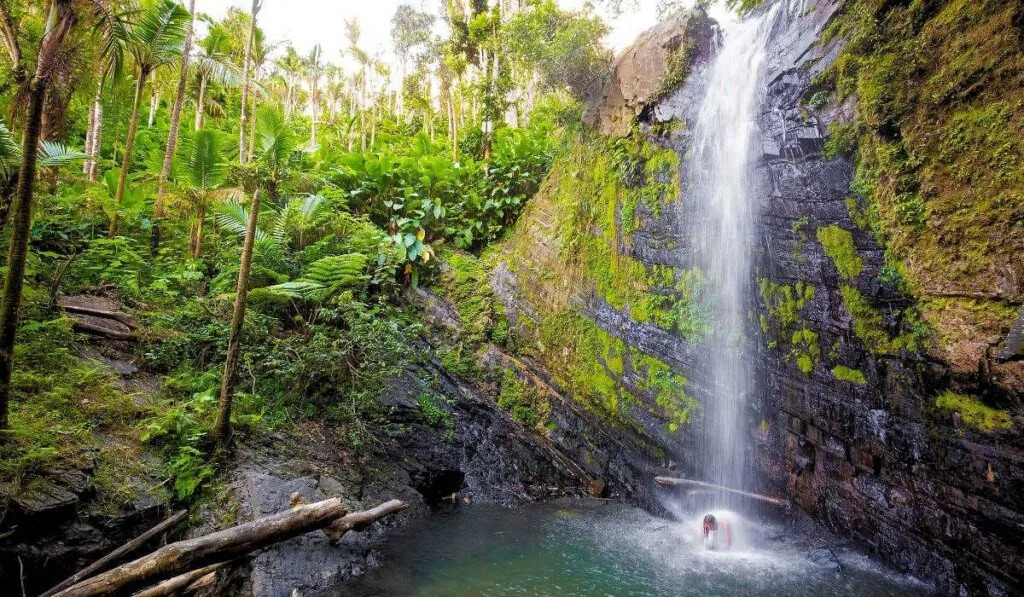
Hike To La Mina Falls
La Mina Falls requires a short 30-to-45-minute hike to see this cascade. The path starts at the Palo Colorado information center to the 35-foot waterfall.
While La Mina Falls is a popular place to swim, it’s currently closed due to hurricane damage. The area hopes to be open again in 2023.
Enjoy The Views From El Yunque Peak
At 3,496 feet, El Yunque Peak provides a great view of Puerto Rico’s landscape and its rainforest canopy, which makes up almost half of the island.
To access the peak, you’ll need to take a moderate to challenging hike. Depending on your fitness level, plan for 3 to 4 hours to complete the round-trip hike.
Once at the top, be sure to snap some photos while taking in all these gorgeous vistas. You’ll see the Caribbean to the South, the Atlantic to the north, and panoramic views of San Juan westwards.
Since the area is prone to afternoon rain showers, plan to go in the morning for a greater chance of experiencing clear weather.
If your day in El Yunque is cut short due to muddy trails, head to Luquillo Beach. The long crescent-shaped oasis has calm waters due to offshore reefs. It’s a great hangout if you’re traveling with family.
Old San Juan Food Tour
After all that strenuous outdoor activity, plan to end the day with authentic Puerto Rico food. There’s no better way to learn about their local dishes than on a San Juan food tour.
A 3-hour food tour will allow you to wander the cobblestone streets, and dine at various locally owned restaurants. The event includes dishes inspired by the area’s Taíno Indian, African, and Spanish roots.
You may sample an appetizer of ceviche made from the freshest seafood, properly roasted pork, and Mofongo (deep-fried plantains filled with garlic, chicken, shrimp, or pork).
Many options are available, and they can be done on your own or with a guide. If you choose to embark on a self-guided tour, you can explore the area on your own terms and at your own pace.
But if you want more guidance in choosing where to go and what kind of food each place has, participate in a small group tour. Going with a guide will give you a brief history lesson as you walk from one establishment to another.
Day 3 – Road Trip To The Interior
Since you have already spent two days on the island, and have gotten a good grasp of the area, now is the best time to enjoy a road trip around Puerto Rico.
Discover Camuy River Cave Park
Naturalists and curious sightseers flock to Rio Camuy Cave Park in Puerto Rico. They are attracted to the cavern’s towering chambers, million-year-old stalactites and stalagmites, and its underground river.
Located in the northwest region, the park opens from 8 am to 3 pm on Wednesdays to Sundays. The limestone caves result from the world’s third largest subterranean river, the Rio Camuy.

So far, cave-goers have mapped a network of 10 miles of tunnels, over 220 individual caverns, and 17 different entrances. While this is a tiny part of the overall cave system, visitors can only access a specific section.
Entering the caves, you’ll be astonished at their size. Some reach heights of over 150 feet and widths as large as 200 feet. The cool, darkened caverns glisten as sunlight peers through small openings.
Inhabitants of the region’s original culture had utilized the caverns for centuries as a safe place, but it wasn’t until 1958 that westerners stumbled onto the underground river system.
These underground passages ooze with an air of mystery and antiquity. And beware the swarm of bats that call the gloom home.
Learn About Astronomy At Arecibo Observatory
The Puerto Rico Observatory is a wonderful addition to your itinerary to add a unique learning experience. It takes a drive on a windy road to get there, and a reservation is required online to visit.
The Arecibo Observatory has one of the world’s biggest radio telescopes. They used it to investigate the ionosphere and surrounding planets as they passed above.
However, after Hurricane Maria and numerous earthquakes, the 1,000-foot telescope collapsed in 2020. Beyond repair, the telescope has been decommissioned and being removed.

The facility does have a smaller LIDAR telescope and plans to build a new telescope with newer technology.
Additionally, it has a museum devoted to scientific education. Inside, you’ll find biology, physics, and space exploration exhibits. The displays are interactive and include a few meteors.
The Arecibo Observatory gained notoriety when featured in 007 Golden Eye and Contact with star Jodie Foster.
Caguana Ceremonial Indigenous Heritage Center
The Caguana Indigenous Ceremonial Site is the most significant Taíno archeological site in the Caribbean’ It gives tourists a valuable insight into the native civilizations that inhabited the area before Spanish colonization.
The park attracts visitors to the ten ceremonial plazas or “bateys” and numerous petroglyphs.
A small museum houses a collection of spears, bows, arrows, and Indian artifacts used by Native Americans.
Outside, a garden features the plants sourced for food, such as corn, cassava, and sweet potatoes.
When visiting the Caguana Ceremonial Indigenous Heritage Center, be prepared to spend at least an hour or two. It’s a great way to get in touch with Puerto Rico’s rich cultural history while exploring the natural beauty of this beautiful country.
Day 4 – Vieques Island
Vieques (or Isla de Vieques) is a beautiful island off the northeast coast of Puerto Rico. It offers plenty of relaxation and adventure, making it the ideal stop to conclude your 4-day trip to Puerto Rico.
The island consists of rolling hills and has a black sand beach. A wildlife sanctuary occupies 60% of the island. So, what can you do on Vieques Island?

Visit Vieques National Wildlife Refuge
Once owned by the US navy, the almost 18,000 acres of land now make up the Vieques National Wildlife Refuge. It’s a diverse landscape, occupying the eastern and western ends of the island.
You can explore this refuge on your own or take a guided tour. The guides will tell you about the animals that call this island home. They will also shed light on the area’s historical significance, the role pirates played here, and why it’s essential today.
Vieques is the ideal playground if you’re into hiking, kayaking, snorkeling, paddle boarding, or horseback riding. Fishing is also allowed on beaches and in the lagoons.
If you’re prepared to get wet, the rich marine waters could offer sightings of dolphins, manatees, reef sharks, and sea turtles.
The refuge has mangrove wetlands, salt flats, lagoons, and several beaches. These areas are home to brown pelicans, sea turtles, horses, and many species of birds. While the horses aren’t wild, they are free to roam the island.

Unwind At Playa La Chiva
Playa La Chiva, also known as La Chiva Beach, is a quiet, sandy oasis near the southern tip of the Vieques National Wildlife Refuge.
When you arrive at Playa La Chiva, expect to see people relaxing on their towels or chairs, reading books or magazines, and looking out over this beautiful view with palm trees surrounding them.
Rated as one of Puerto Rico’s best beaches and once known as “Blue Beach,” the water radiates changing hues. The shallows have turquoise tones, which turn to navy blues in deeper waters.
Enjoy Authentic Puerto Rican Food
Vieques is a paradise for foodies, with a wide variety of high-quality restaurants to choose from. The island’s restaurants have beautiful surroundings and inventive takes on traditional Puerto Rican cuisine prepared by talented chefs.
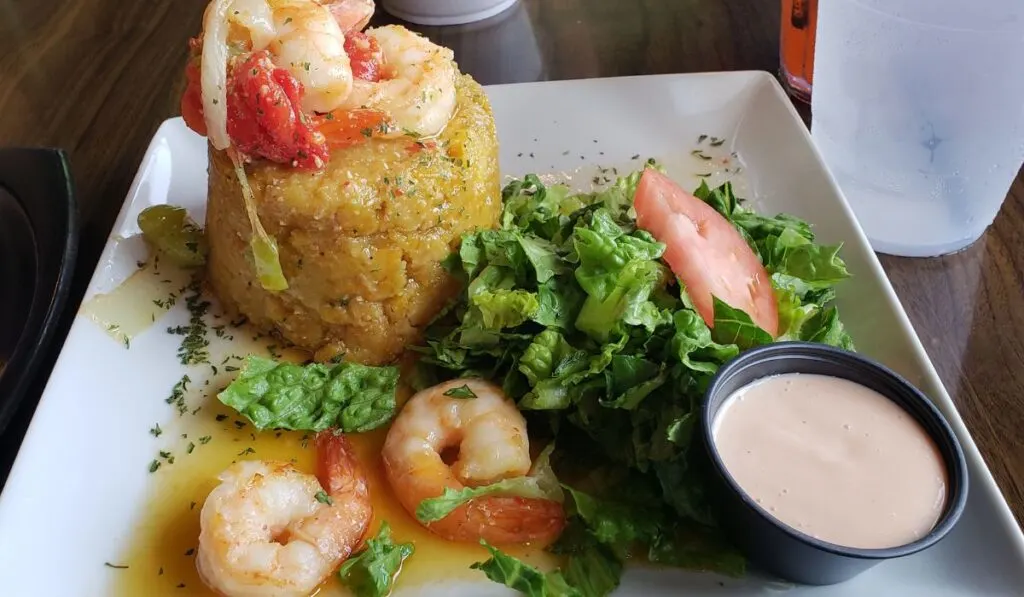
The two most popular restaurants are Coqui Fire Cafe and El Quenepo, providing creatively presented meals using locally sourced ingredients.
Coqui Fire Café serves meals with a kick. It’s a must-visit if you like spicy food. Their meals all have fiery flavors, and you can accompany them with a margarita with spicy salt and hot sauce.
The restaurant offers gluten-free and vegan choices.
El Quenepo has an upscale atmosphere and a scrumptious menu. Their ceviche and mole are exceptional. Their dishes, while pricey, are innovative and beautifully displayed.
Be sure to leave room for their Goat Cheese Cheesecake with Pistachio Anglaise. The ambiance and locale near the ocean make it ideal for a romantic night out.
Experience The Magic of Mosquito Bay
There’s no better way to spend your last night in Puerto Rico than exploring the island’s breathtaking bioluminescent bay. While Puerto Rico is blessed with three bioluminescent bays, Mosquito Bay is the best for viewing.
Dinoflagellates in Mosquito Bay on the island of Vieques emit a glow that may be seen from dusk till dawn. The light is so bright that in 2008, the Guinness Book of Records declared it the brightest worldwide.
Viewing is best after a new moon when the skies are darkest for optimal viewing. You can plan to view from a power boat or take a kayak tour. Swimming in the bay is strictly prohibited. If you want to swim, La Parguera bioluminescent bay permits swimming.
If you plan a kayaking tour, you get up close to the unique biological emission of light. Overall, the experience is fantastic. Plan ahead and get your tickets here.
The microscopic organisms will emit a glowing light with every stroke of your paddle. Be warned, the glowing lights are difficult to capture in a photo.
Imagine watching millions of “stars” light up with a dazzling blue-white radiance and scatter when you create a splash. How cool is that?
Wrap it up!
Puerto Rico offers many things to do, from learning its culture and history to exploring its jungle and beautiful landscape. The hardest part about creating a unique Puerto Rico itinerary is determining what to include.
However, with this comprehensive four-day itinerary, you’ll see Puerto Rico’s best sites and enjoy its outdoors too. After one trip, you’ll want to return to “La Isla del Encanto,” also known as the Island of Enchantment.
During your trip, try to connect with the locals. They can often recommend the best bars and food hot spots. You may even discover hidden gems amongst the colorful buildings and cobblestone streets.

